
|
시장보고서
상품코드
1837232
서멀 프린트 시장 : 프린터 유형, 기술, 연결성, 프린트 해상도, 용도, 최종사용자별 - 세계 예측(2025-2032년)Thermal Printing Market by Printer Type, Technology, Connectivity, Print Resolution, Application, End User - Global Forecast 2025-2032 |
||||||
서멀 프린트 시장은 2032년까지 CAGR 5.45%로 657억 달러로 성장할 것으로 예측됩니다.
| 주요 시장 통계 | |
|---|---|
| 기준 연도 2024년 | 429억 6,000만 달러 |
| 추정 연도 2025년 | 453억 1,000만 달러 |
| 예측 연도 2032 | 657억 달러 |
| CAGR(%) | 5.45% |
열전사 인쇄의 진화와 다양한 산업 및 상업용 워크플로우에 필수적인 이유에 대한 명확한 기본 이해 확립
감열 인쇄 기술은 라벨링, 티켓팅, 주문형 문서화 워크플로우에서 기본적인 역할을 계속하고 있습니다. 속도, 낮은 운영 비용, 최소한의 유지보수 등 핵심적인 장점은 산업계에서 폭넓은 채택을 유지하고 있으며, 재료 과학, 전자제품의 소형화, 임베디드 소프트웨어의 반복적인 발전으로 인해 실제 매장과 현장 모두에서 사용 사례가 확대되고 있습니다.
지난 몇 년 동안 헬스케어 관리자부터 물류업체에 이르기까지 다양한 이해관계자들이 신뢰성과 추적성을 우선순위에 두고 있으며, 일관된 인쇄 품질, 내구성 있는 소모품, 안전한 연결성에 대한 중요성이 커지고 있습니다. 그 결과, 제품 로드맵에서 모듈성, 기업 시스템과의 통합 용이성, 펌웨어 수준의 보안이 점점 더 강조되고 있습니다. 그 결과, 구매 의사결정은 순수한 거래적 교환에서 장기적인 가동시간과 상호운용성을 중시하는 라이프사이클 조달 모델로 전환되고 있습니다.
기술, 운영 및 연결성의 집약적인 힘으로 열전사 프린터를 독립형 장치에서 지능형 네트워크 엔드포인트로 재정의하는 기술, 운영 및 연결성에 대해 설명합니다.
기술, 공급망 아키텍처 및 최종사용자의 기대에 수렴하는 힘으로 인해 열전사 인쇄 환경은 일련의 혁신적인 변화가 일어나고 있습니다. 열전사 제형과 고해상도 직접 감열 코팅의 발전으로 더 미세한 바코드와 고밀도 그래픽 요소가 가능해져 보다 정교한 제품 추적 및 컴플라이언스 라벨링 이니셔티브를 지원할 수 있게 되었습니다. 한편, 프린터 엣지에 내장된 인텔리전스는 장비 관리를 간소화하고, 예측 유지보수를 가능하게 하며, 원격 측정 및 원격 업데이트를 통해 예기치 않은 다운타임을 줄입니다.
동시에, 무선 연결 옵션과 표준화된 API의 보급으로 클라우드 네이티브 에코시스템에 대한 통합이 간소화되어 프린터가 분산형 데이터 워크플로우의 노드가 될 수 있게 되었습니다. 이러한 전환으로 인해 현장 사용을 견딜 수 있는 견고함과 신속한 배포를 위한 소프트웨어의 유연성이 균형을 이루는 디바이스에 대한 수요가 증가하고 있습니다. 요약하면, 업계는 고립된 어플라이언스와 같은 기기에서 최신 IT 거버넌스 및 운영 탄력성 전략에 따라 네트워크를 의식한 소프트웨어 정의 주변기기로 전환하고 있습니다.
최근 관세 조정이 열전사 인쇄 가치사슬 전반의 조달 전략, 공급 연속성 대책, 조달 관행을 어떻게 재구성하고 있는지 분석합니다.
관세의 변화와 무역 정책의 전환은 세계 조달 전략과 공급업체 선택에 새로운 변수를 도입했습니다. 제조업체와 조달팀에게 최근 수입 관세 조정은 부품 조달, 생산 공간, 재고 버퍼에 대한 재평가를 촉구하고 있습니다. 이러한 정책 주도의 역동성은 공급업체 포트폴리오를 다양화하고, 중요한 하위 어셈블리 생산을 현지화하며, 갑작스러운 비용 상승에 대한 노출을 줄이기 위해 이중 조달 계약을 체결할 인센티브를 높이는 연쇄 효과를 가져옵니다.
또한, 조달 주기는 토지 비용의 변동에 더욱 민감하게 반응하여 조달, 물류 및 재무 부서 간의 보다 강력한 협업을 촉진하고 있습니다. 이에 따라 많은 기업들이 가격 조정 조항을 포함한 계약 조건을 재조정하고, 마진의 일관성과 공급의 연속성을 유지하기 위해 지역 제조 파트너십을 모색하고 있습니다. 따라서 공급망 아키텍처를 적극적으로 재설계하고 시나리오 플래닝을 도입하는 기업은 서비스 수준을 유지하면서 관세 관련 혼란을 흡수할 수 있는 유리한 입장에 서게 될 것입니다.
프린터 유형, 기술, 연결 옵션, 해상도, 용도, 최종사용자의 우선 순위를 실용적인 제품 전략으로 연결하여 미묘한 세분화 인텔리전스를 제공합니다.
강력한 세분화 분석을 통해 명확한 업무 프로필에 따라 차별화된 제품 및 솔루션에 대한 요구사항을 파악할 수 있습니다. 프린터 유형에 따라 제품에 대한 기대치는 소형 경량 디바이스가 설치 공간의 효율성과 사용 편의성을 우선시하는 데스크톱 제품과 표준 및 대형 플랫폼을 통해 제공되는 높은 처리량과 내구성을 요구하는 산업용 시스템으로 나뉩니다. 모바일 프린팅은 가벼운 현장 스캐닝에 최적화된 휴대용 유닛과 열악한 환경을 위해 설계된 견고한 변형으로 나뉘며, 각각 고유한 이동성 및 설치 고려 사항을 충족합니다.
목차
제1장 서문
제2장 조사 방법
제3장 주요 요약
제4장 시장 개요
제5장 시장 인사이트
제6장 미국 관세의 누적 영향 2025
제7장 AI의 누적 영향 2025
제8장 서멀 프린트 시장 : 프린터 유형별
- 데스크톱
- 컴팩트
- 경작업용
- 산업
- 표준
- 와이드 포맷
- 모바일
- 휴대용
- 러기드
제9장 서멀 프린트 시장 : 기술별
- 다이렉트 서멀
- 열전사
- 수지
- 왁스
- 왁스 수지
제10장 서멀 프린트 시장 : 연결성별
- 이더넷
- 시리얼
- USB
- 무선
제11장 서멀 프린트 시장 : 인쇄 해상도별
- 203DPI
- 300DPI
- 600DPI
제12장 서멀 프린트 시장 : 용도별
- 헬스케어
- 제조업
- 소매
- 운송 물류
제13장 서멀 프린트 시장 : 최종사용자별
- 정부
- 헬스케어
- 물류
- 제조업
- 소매
제14장 서멀 프린트 시장 : 지역별
- 아메리카
- 북미
- 라틴아메리카
- 유럽, 중동 및 아프리카
- 유럽
- 중동
- 아프리카
- 아시아태평양
제15장 서멀 프린트 시장 : 그룹별
- ASEAN
- GCC
- EU
- BRICS
- G7
- NATO
제16장 서멀 프린트 시장 : 국가별
- 미국
- 캐나다
- 멕시코
- 브라질
- 영국
- 독일
- 프랑스
- 러시아
- 이탈리아
- 스페인
- 중국
- 인도
- 일본
- 호주
- 한국
제17장 경쟁 구도
- 시장 점유율 분석, 2024
- FPNV 포지셔닝 매트릭스, 2024
- 경쟁 분석
- Zebra Technologies Corporation
- Brother Industries, Ltd.
- Seiko Epson Corporation
- Honeywell International Inc.
- SATO Holdings Corporation
- Toshiba Tec Corporation
- TSC Auto ID Technology Co., Ltd.
- Citizen Systems Japan Co., Ltd.
- Star Micronics Co., Ltd.
- Dai Nippon Printing Co., Ltd.
The Thermal Printing Market is projected to grow by USD 65.70 billion at a CAGR of 5.45% by 2032.
| KEY MARKET STATISTICS | |
|---|---|
| Base Year [2024] | USD 42.96 billion |
| Estimated Year [2025] | USD 45.31 billion |
| Forecast Year [2032] | USD 65.70 billion |
| CAGR (%) | 5.45% |
Establishing a clear foundational understanding of thermal printing evolution and why it remains essential across diverse industrial and commercial workflows
Thermal printing technology continues to play a foundational role across labeling, ticketing, and on-demand documentation workflows. Its core advantages-speed, low running cost, and minimal maintenance-have sustained broad industry adoption, while iterative advances in materials science, electronics miniaturization, and embedded software have expanded use cases in both brick-and-mortar and field operations.
Over the past several years, stakeholders from healthcare administrators to logistics operators have prioritized reliability and traceability, which has elevated the importance of consistent print quality, durable consumables, and secure connectivity. As a result, product roadmaps increasingly emphasize modularity, ease of integration with enterprise systems, and firmware-level security. Consequently, purchasing decisions are shifting from purely transactional replacements toward lifecycle procurement models that value long-term uptime and interoperability.
Explaining the converging technological, operational, and connectivity forces that are redefining thermal printing from standalone devices to intelligent networked endpoints
The thermal printing landscape is undergoing a set of transformative shifts driven by converging forces across technology, supply chain architecture, and end-user expectations. Advances in thermal transfer formulations and high-resolution direct thermal coatings are enabling finer barcodes and denser graphic elements, which in turn support more sophisticated product tracking and compliance labeling initiatives. Meanwhile, embedded intelligence at the printer edge is streamlining device management, enabling predictive maintenance, and reducing unplanned downtime through telemetry and remote updates.
Concurrently, the proliferation of wireless connectivity options and standardized APIs is simplifying integration into cloud-native ecosystems, allowing printers to become nodes in distributed data workflows. This transition is reinforcing demand for devices that balance ruggedization for field use with software flexibility for rapid deployment. In summary, the industry is moving from isolated, appliance-like devices toward network-aware, software-defined peripherals that align with modern IT governance and operational resilience strategies.
Analyzing how recent tariff adjustments are reshaping sourcing strategies, supply continuity measures, and procurement practices across the thermal printing value chain
Tariff changes and trade policy shifts have introduced new variables to global sourcing strategies and supplier selection. For manufacturers and procurement teams, recent adjustments to import duties have prompted reassessment of component sourcing, production footprints, and inventory buffers. These policy-driven dynamics have a cascading effect: they increase the incentive to diversify supplier portfolios, localize critical subassembly production, and establish dual-sourcing arrangements to mitigate exposure to sudden cost escalations.
Moreover, procurement cycles have become more sensitive to landed cost volatility, encouraging stronger collaboration between sourcing, logistics, and finance functions. In response, many organizations are recalibrating contractual terms to include price adjustment clauses and exploring regional manufacturing partnerships to preserve margin integrity and supply continuity. Consequently, companies that proactively redesign supply chain architectures and incorporate scenario planning are better positioned to absorb tariff-related disruptions while maintaining service levels.
Delivering nuanced segmentation intelligence that links printer types, technologies, connectivity choices, resolutions, applications, and end-user priorities into actionable product strategies
Robust segmentation analysis reveals differentiated product and solution requirements that align with distinct operational profiles. Based on printer type, product expectations bifurcate across desktop offerings-where compact and light-duty devices prioritize footprint efficiency and ease of use-and industrial systems that demand higher throughput and durability, delivered through standard and wide format platforms. Mobile printing further divides into portable units optimized for light field scanning and rugged variants engineered for extreme environments, each addressing unique mobility and mounting considerations.
Based on technology, the direct thermal pathway excels for short-lived labels and simplified media handling, while thermal transfer solutions provide resilience for long-life identification through resin, wax, and wax-resin consumable chemistries that trade off durability, print density, and substrate compatibility. Based on connectivity, deployment scenarios are shaped by interface needs such as Ethernet for stable networked installations, serial and USB for legacy integration, and wireless options that enable distributed, on-demand printing across decentralized operations. Based on print resolution, application requirements vary from 203 DPI for standard barcode and receipt tasks to higher 300 DPI and 600 DPI options that support small-form-factor text, fine graphics, and high-density codes for traceability and compliance.
Based on application, vertical-specific drivers pinpoint solution priorities: healthcare emphasizes sterilizable materials and patient identification reliability; manufacturing demands robust adhesive systems and resistance to production-line exposures; retail focuses on speed and consumer-facing label quality; and transportation logistics requires durable labels that survive handling and environmental stressors. Based on end user, procurement cycles and service expectations differ between government entities seeking long procurement horizons and high compliance, healthcare organizations prioritizing sterile workflows and regulatory traceability, logistics providers emphasizing uptime and ruggedization, manufacturing customers valuing integration with MES and ERP systems, and retail chains favoring rapid rollouts and low total cost of ownership.
Unpacking how regional economic structures, regulatory priorities, and operational demands across the Americas, Europe Middle East & Africa, and Asia-Pacific drive differentiated adoption patterns
Regional dynamics are shaping demand patterns, supplier strategies, and investment priorities in differentiated ways. In the Americas, enterprise adoption is often driven by large-scale distribution networks and retail modernization projects, with emphasis on cloud-enabled fleet management and integration into omnichannel fulfillment architectures. Capital access and mature logistics ecosystems create fertile conditions for investment in high-availability devices and advanced consumable management practices.
Europe, Middle East & Africa presents a heterogeneous landscape where regulatory alignment, sustainability imperatives, and localized manufacturing influence procurement behavior. In many European markets, extended producer responsibility and recyclability considerations are elevating demand for consumables with improved environmental credentials, while in several EMEA economies cost-sensitive deployments still favor proven, durable thermal transfer systems. Across the region, interoperability with regional labeling standards and language support remains a critical procurement criterion.
Asia-Pacific exhibits a blend of rapid adoption in warehouse automation, urban retail expansion, and healthcare modernization. Supply chain nodes across the region serve both as production hubs and high-volume deployment centers, with manufacturers and integrators focusing on scalable solutions that accommodate diverse infrastructure conditions. Collectively, these regional characteristics necessitate differentiated go-to-market models, localized service networks, and targeted product portfolios that reflect varying regulatory, operational, and commercial contexts.
Examining competitive dynamics where hardware incumbents, consumable innovators, and software-first players converge to redefine value delivery across the thermal printing ecosystem
Competitive dynamics within the thermal printing ecosystem are characterized by a mixture of long-standing hardware incumbents, specialized consumable manufacturers, and emerging software-centric entrants. Legacy OEMs retain advantages in established distribution channels, spare-part networks, and industrial-grade platform engineering, while nimble suppliers are differentiating through modular software, faster firmware updates, and specialized consumable chemistries. These shifts are narrowing the gap between hardware specification and value-added services, placing a premium on after-sales support and device lifecycle programs.
Partnerships and channel strategies also influence competitive positioning, as resellers and systems integrators act as critical conduits for vertical-specific solution delivery. Strategic alliances that combine printing hardware with middleware, label design solutions, and enterprise connectivity tools are increasingly common, enabling vendors to offer comprehensive solutions that address end-to-end operational pain points. Consequently, companies that invest in developer ecosystems, certification programs, and comprehensive service level agreements are best placed to win complex, mission-critical contracts.
Offering practical and high-impact strategic moves for product, supply chain, and commercial teams to enhance resilience, capture recurring value, and accelerate adoption
To remain competitive and resilient, leaders should pursue a set of practical, high-impact initiatives that align product, supply chain, and commercial strategies. First, prioritize modular product designs that allow rapid field upgrades for connectivity and security, reducing the need for wholesale hardware replacement. This approach conserves capital and shortens time-to-value for new features. Next, diversify supplier bases for critical components and review contract terms to incorporate flexibility for duty and tariff variability, thereby reducing single-source exposure and improving negotiating leverage.
Simultaneously, invest in digital services such as fleet telemetry, consumable lifecycle analytics, and firmware orchestration to create recurring revenue streams and deepen customer relationships through value-added service packages. Additionally, tailor go-to-market models to regional differences by localizing service networks, extending language and compliance support, and offering deployment pilots that lower adoption friction. Finally, strengthen partnerships with systems integrators and software providers to bundle printing hardware with label management and data capture solutions, creating clearer value propositions for enterprise buyers and shortening sales cycles.
Describing a multi-method research approach combining primary stakeholder interviews, technical validation, and cross-referenced documentation to ensure robust and reproducible insights
This research synthesized primary interviews with procurement leaders, technical managers, and solution architects across multiple verticals, complemented by a systematic review of product literature, firmware release notes, and interoperability documentation from leading vendors. Qualitative insights were triangulated through device teardown analyses, consumable compatibility testing, and hands-on assessments of connectivity stacks to validate claims regarding print durability, resolution fidelity, and integration ease.
Where applicable, trend identification leveraged thematic coding of interview transcripts and cross-referencing with industry technical standards to ensure that observed patterns were representative across deployment contexts. The methodology emphasized transparency and reproducibility: data sources and testing protocols were documented to support follow-up inquiries, and opportunities for custom validation were made available to purchasers seeking bespoke analytical extensions. Throughout, care was taken to avoid reliance on a single data type or vendor perspective, favoring a holistic, multi-modal research approach.
Synthesizing technology progress, policy effects, and commercial imperatives to clarify how thermal printing will persist as a critical infrastructure component for enterprises
The cumulative analysis underscores that thermal printing remains a strategic enabler for traceability, customer experience, and operational efficiency across diverse industries. Technological progress in consumables, resolution options, and embedded software is expanding applicability, while supply chain and policy shifts are prompting pragmatic adjustments in sourcing and deployment strategies. As organizations balance cost, sustainability, and uptime, the competitive landscape is rewarding vendors that deliver integrated solutions combining hardware reliability with robust software services.
Looking ahead, stakeholders who align product development with evolving regulatory requirements, invest in connectivity and device management, and adopt resilient sourcing strategies will be better positioned to support complex operational environments. In short, thermal printing will continue to be a core infrastructure element, but its value will increasingly be realized through software-enabled services, adaptable hardware configurations, and regionally attuned commercial models.
Table of Contents
1. Preface
- 1.1. Objectives of the Study
- 1.2. Market Segmentation & Coverage
- 1.3. Years Considered for the Study
- 1.4. Currency & Pricing
- 1.5. Language
- 1.6. Stakeholders
2. Research Methodology
3. Executive Summary
4. Market Overview
5. Market Insights
- 5.1. Integration of near-field communication and thermal printing for secure mobile payment receipts
- 5.2. Expansion of eco-friendly thermal paper alternatives to reduce bisphenol exposure risks in healthcare
- 5.3. Rising demand for high-resolution thermal printers in logistics for detailed barcode and label clarity
- 5.4. Use of AI-driven print management software to optimize thermal printer maintenance schedules and reduce downtime
- 5.5. Growth of portable thermal printing devices supporting wireless connectivity for field service operations
- 5.6. Incorporation of antimicrobial coatings on thermal printing surfaces for hygiene in food service environments
- 5.7. Development of energy-efficient thermal printheads to address sustainability goals in manufacturing facilities
- 5.8. Advancements in color thermal transfer printing for durable graphical labels in pharmaceutical packaging sectors
6. Cumulative Impact of United States Tariffs 2025
7. Cumulative Impact of Artificial Intelligence 2025
8. Thermal Printing Market, by Printer Type
- 8.1. Desktop
- 8.1.1. Compact
- 8.1.2. Light Duty
- 8.2. Industrial
- 8.2.1. Standard
- 8.2.2. Wide Format
- 8.3. Mobile
- 8.3.1. Portable
- 8.3.2. Rugged
9. Thermal Printing Market, by Technology
- 9.1. Direct Thermal
- 9.2. Thermal Transfer
- 9.2.1. Resin
- 9.2.2. Wax
- 9.2.3. Wax Resin
10. Thermal Printing Market, by Connectivity
- 10.1. Ethernet
- 10.2. Serial
- 10.3. USB
- 10.4. Wireless
11. Thermal Printing Market, by Print Resolution
- 11.1. 203 DPI
- 11.2. 300 DPI
- 11.3. 600 DPI
12. Thermal Printing Market, by Application
- 12.1. Healthcare
- 12.2. Manufacturing
- 12.3. Retail
- 12.4. Transportation Logistics
13. Thermal Printing Market, by End User
- 13.1. Government
- 13.2. Healthcare
- 13.3. Logistics
- 13.4. Manufacturing
- 13.5. Retail
14. Thermal Printing Market, by Region
- 14.1. Americas
- 14.1.1. North America
- 14.1.2. Latin America
- 14.2. Europe, Middle East & Africa
- 14.2.1. Europe
- 14.2.2. Middle East
- 14.2.3. Africa
- 14.3. Asia-Pacific
15. Thermal Printing Market, by Group
- 15.1. ASEAN
- 15.2. GCC
- 15.3. European Union
- 15.4. BRICS
- 15.5. G7
- 15.6. NATO
16. Thermal Printing Market, by Country
- 16.1. United States
- 16.2. Canada
- 16.3. Mexico
- 16.4. Brazil
- 16.5. United Kingdom
- 16.6. Germany
- 16.7. France
- 16.8. Russia
- 16.9. Italy
- 16.10. Spain
- 16.11. China
- 16.12. India
- 16.13. Japan
- 16.14. Australia
- 16.15. South Korea
17. Competitive Landscape
- 17.1. Market Share Analysis, 2024
- 17.2. FPNV Positioning Matrix, 2024
- 17.3. Competitive Analysis
- 17.3.1. Zebra Technologies Corporation
- 17.3.2. Brother Industries, Ltd.
- 17.3.3. Seiko Epson Corporation
- 17.3.4. Honeywell International Inc.
- 17.3.5. SATO Holdings Corporation
- 17.3.6. Toshiba Tec Corporation
- 17.3.7. TSC Auto ID Technology Co., Ltd.
- 17.3.8. Citizen Systems Japan Co., Ltd.
- 17.3.9. Star Micronics Co., Ltd.
- 17.3.10. Dai Nippon Printing Co., Ltd.



















